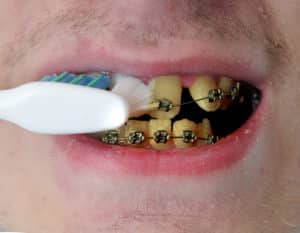E-Cigarettes: An Update On Safety
E-Cigarettes: An Update On Safety and New Warnings
In the winter of 2014, we published an article about e-cigarettes – exploring the risks to users’ oral health. In case you missed it, you can read it here.
At the time we wrote the article, there were several studies underway to determine the safety of e-cigarettes. Although a number of studies are still ongoing, some of the data is now available, and it doesn’t look good for e-cigarettes.
A quick review
E-Cigarettes convert nicotine into vapor, which is delivered into the mouth and bloodstream of the user. Since they produce vapor rather than smoke, they must be safer, correct?

You may be absorbing a much higher concentration of nicotine, diethylene glycol (found in antifreeze) and formaldehyde with e-cigarettes.
Nicotine and tooth decay
We know that smokers lose their teeth at double the rate of non-smokers, and that they’re four times more likely to develop gum disease. The most prevalent chemical in cigarettes is nicotine, known to cause the following:
- Constricted arteries, making your heart work harder to pump blood through your body. Repeated exposure to nicotine contributes to coronary artery disease, high blood pressure, and heart attacks.
- Fat and cholesterol are released into your bloodstream when triggered by nicotine
- Slow wound healing, stroke, and peptic ulcers
- Oral cancer
- Periodontal (gum) disease
Inhaled nicotine reaches your brain in 7 seconds.
Formaldehyde is a known carcinogen. Because the levels of formaldehyde are up to ten times higher in e-cigarettes than conventional cigarettes, dentists and oral surgeons are gravely concerned about a subsequent rise in the cases of oral cancer. In the United States, oral cancer is already a killer – it claims an average of one life every hour of every day. Imagine if this statistic rises in correlation to the increased level of formaldehyde in e-cigarettes?
Marketing to children
It’s no secret that e-cigarettes are marketed to children. A quick search on Google reveals flavored nicotine laced liquids such as ‘Coffee Cake’, ‘Gummy Bear’, ‘Huckleberry Ice Cream’, and ‘Bubble Gum’, which are clearly made to sound attractive to young prospects. Blu e-cigs even recently ran an ad with their logo plastered squarely across the pubic area of a teen in a bikini, which stated ‘slim, charged, ready to go’, inferring that teens who vaped were inherently more cool and edgy than their peers.
Sadly, the number of teens and tweens using these products doubled between 2011 and 2012. In fact, e-cigarettes will likely outsell conventional cigarettes within the next decade. What’s frightening is that the effect of nicotine on developing brains is even more dangerous than it is to adults.
A research paper released by the National Institute for Health found that ‘early exposure to nicotine during the transition from child to adult may be harmful, since it may derange the normal course of brain maturation and have lasting consequences for cognitive ability, mental health, and even personality.’ The research further found that adolescents become dependent on nicotine much faster than adults. Since the oral health consequences of nicotine exposure tend to be cumulative, the use of e-cigarettes in adolescents as young as 12 or 13 is potentially devastating. The rates of oral cancer, gum disease and tooth loss could be occurring in increasingly younger populations.
Because there is no tell-tale ‘smoke’ odor, it can be difficult for parents to know if their teens are using e-cigarettes. Nicotine is especially dangerous for young children: A teaspoon of a typical e-liquid contains enough nicotine to be lethal to an adult; smaller amounts would be lethal to a child. In the United States the number of cases of child poisoning linked to e-liquids was 1,543 in 2013 and nearly 4,000 in 2014.

Study Results
The Center for Environmental Health released the results of a study this month which reached alarming conclusions. Not only are the concentrations of Nicotine and Diethylene Glycol much higher in e-cigarettes, but ‘vapers’ (those who use e-cigarettes) are getting dangerously high levels of Formaldehyde and Acetaldehyde with every puff. These are known carcinogens, and the amount in e-cigarettes exceeds the levels deemed ‘safe’ under Proposition 65, the Safe Drinking Water and Toxic Enforcement Act of 1986. This study mirrored one which was published in the Journal of American Medicine which found that chemical concentrations in the liquids used in e-cigarettes were much higher than those found in traditional cigarettes. Here’s a link to the study by the CEH.
According to new studies detailed at the 2015 American Thoracic Society International Conference in Denver Colorado this month, the increased levels of toxic chemicals released by e-cigarettes were particularly concerning when the cumulative effect was considered. It turns out that the flavorings added to e-cig liquids may be even more potentially damaging than the non-flavored varieties. The University of North Carolina Cell Biology and Physiology Department found changes in cell viability and proliferation. In other words, the ability of cells to stay alive and replicate was compromised.
The National Institute of Dental and Craniofacial Research Report
The NIDCR, part of the National Institute of Health, issued a report late last year to the American Dental Association. They see an ‘urgent need to determine their true biological effects on oral tissues’. Their report found that e-cigarettes’ present a potential oral cancer and periodontal disease risk for users, due to their higher exposure to these chemical mixtures’.
Regulation and Standardization
The Food and Drug Administration and Centers for Disease Control and Prevention are currently drafting legislation to require both regulation and standardization. E-cigarettes now vary so widely in their nicotine solutions, vapor substances, additives, delivery system and combustion methods; they present a ‘moving target’ for researchers.
What Does This Mean for Your Child?
Given that e-cigarettes contain an average of 10 times the nicotine as conventional cigarettes, it is logical to surmise that the cases of tooth decay, gum disease and oral cancer would rise accordingly. The increasingly young age at which children begin to use e-cigarettes will also presumably result in these diseases presenting at a much younger age than ever seen previously.
Nearly 46,000 Americans will be diagnosed with oral or pharyngeal cancer in 2015. It will kill 1 person per hour, 24 hours a day. Of the 46,000, only about 50% will still be alive 5 years from the time of their diagnosis.
64% of smokers suffer from gum disease, and resulting tooth loss. E-cigarettes are likely to exponentially increase those numbers.
None of us wants our children to suffer the terrible consequences of nicotine exposure. Early education is the key to helping your child make good decisions about his or her oral health. When children are very young, it seems to them that nothing will ever happen to them. It’s only long after they become addicted to nicotine that they begin to realize the potential effects.
If your child is talking about e-cigarettes and peer pressure, let us know at their next visit. We want to partner with you in keeping your child’s teeth and gums healthy and their smile beautiful!













